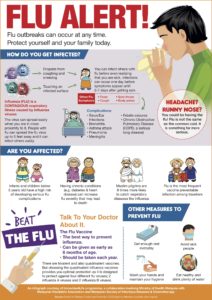Keep your children healthy throughout the new school year with a flu vaccination.
 When school began earlier this year, you may have been one of those parents who experienced mixed feelings of relief and dread.
When school began earlier this year, you may have been one of those parents who experienced mixed feelings of relief and dread.
Every parent knows what it’s like: you can’t wait to bundle your children off to school, but you also know that the sniffles will soon follow. In no time at all, the whole family will fall sick, one by one. Even after they have recovered, your kid may come home from school, sick again!
Schools and kindergartens are a hotbed for bacteria and viruses. Children play together in close quarters, share food and are not diligent about washing their hands frequently.
Some infections, like the common cold, are mild and short-lived. Others, like influenza, can be dangerous for children. The recent news on influenza-like illness (ILI) affecting school children would very likely make you worry more.
Falling sick is part and parcel of growing up, but we do not have to subject our children to the serious complications of influenza. You could protect yourself and your family members from influenza with the flu vaccine.
Mommy, I feel sick…
You dread having to hear that all-too-familiar complaint from your child. He appears tired, has a cough and fever, and says his body aches: all classic signs of influenza, or the flu.
Many parents mistake influenza for the common cold. Both share similar symptoms, but they are actually caused by different viruses.
The other main difference between the flu and the cold is that the flu is much more serious, resulting in complications like pneumonia, as well as sinus and ear infections.
Children below the age of two years are at higher risk of hospitalisation from the flu, while those between two and five years are at high risk of the complications described above. Some children, such as those with chronic health problems, like asthma, nephrotic syndrome, etc. may even die from the flu.
The flu virus is transmitted through droplets that travel through the air when sick individuals cough, sneeze or talk.
A child may also get the flu by touching surfaces or toys which a person with influenza had touched, and then touching his/her own nose, mouth or eyes. The virus can stay alive on surfaces between two and eight hours.
Sick kids, sick families
When there is an outbreak of influenza in the community, school-aged children are the most vulnerable to being infected.
Children are also a major source of influenza transmission, bringing the virus home and infecting their parents, siblings, grandparents and other family members.
Kids also harbour the virus for a longer period compared to adults, transmitting influenza for 10 or more days after their symptoms begin.
Frequent episodes of the flu take a tremendous toll on the whole family. Children have to skip school, while parents have to take time off from work for costly doctor’s visits.
Protection against flu
When your child falls ill, there is no way of knowing whether it is the harmless cold or the more serious influenza.
That is why flu vaccination is the best way to protect your child and the whole family.
The Centers for Disease Control in the United States recommends annual flu vaccination for children aged six months and above. Some children aged between six months and eight years may require two doses of the vaccine in the beginning.
Children below the age of six months are too young to get the vaccine. Protect them from flu by ensuring that older siblings and other family members, as well as carers at home, are vaccinated.
As the flu virus constantly mutates, you will need to get vaccinated every year. Think of it as part of the school supplies you need to get, along with uniforms and textbooks.
You and your family can break out of the vicious flu cycle. When the kids are healthy, everybody is happy.
An article courtesy of Immunise4Life programme by Ministry of Health Malaysia, in collaboration with Malaysian Paediatric Association and Malaysian Society of Infectious Diseases & Chemotherapy.
